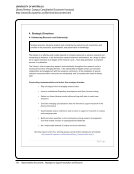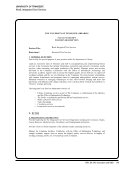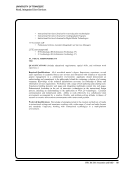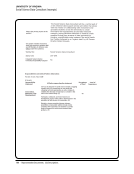30 · Survey Results: Survey Questions and Responses
The idea was brought up in a library planning retreat.
The original idea for this project grew out of conversations with library administration and leadership at the Mellon
Foundation.
The project began long before GIS as a legacy project of a professor of Ecology and Evolutionary Biology. For 15
years students had worked with pre-GIS technology to map the campus trees (CAD?). Students then got training in
the library’s GIS/Data Center to move the data to a public online environment. The library then approached campus
Facilities, Engineering, and Planning to inquire whether they would be interested in tracking additional data to make the
map more widely useful. Examples of this data include: times of planting, trimming, and removal cost of pest removal.
The project idea from a metadata librarian, the Agile methodology came from attending a workshop.
This has been an iterative process component projects largely executed through teams, including most recent
appointment of eLearning lead cohort. All teams represent multiple functional areas.
This innovation was faculty driven. The faculty approached the library as partners.
University administration
University Information Technology Services, our ScholarSphere partner.
6. What forces were driving the need/opportunity for this innovation? Check all that apply. N=44
Opportunity to further institutional/library mission 37 84%
User expectations 27 61%
Competition for resources 12 27%
New source of funding 6 14%
Reduction in library funding 3 7%
Other driving force, please briefly explain 29 66%
A range of user needs were going unmet, while some services were being duplicated at multiple locations some staff
continued to be allocated to work that no longer needed to be done. No new positions were added rather, a number of
existing staff were redeployed in new areas of responsibility.
Attempt to anticipate and respond to evolving user needs.
Attract students to library, increase campus security, increase student convenience and innovation.
Changing instructional methods on campus.
Collecting archival content from the web extends the mission of research libraries to support future research and helps
to guarantee the integrity of current scholarship by preserving ephemeral content that might otherwise be lost (i.e.,
addresses the “link rot” issue).
Community engagement—the project was an effort to experiment with whether or not crowd-sourcing was an
effective approach to making materials accessible more quickly than through existing resources.
Development of an open access policy and limited funds from grants and other sources to publish in open access
journals that require fees.
Efforts to raise the visibility of the library on campus and in the community, and to realign staff organization to better
serve the university’s mission and the modern student. LibQUAL+ survey results.
The idea was brought up in a library planning retreat.
The original idea for this project grew out of conversations with library administration and leadership at the Mellon
Foundation.
The project began long before GIS as a legacy project of a professor of Ecology and Evolutionary Biology. For 15
years students had worked with pre-GIS technology to map the campus trees (CAD?). Students then got training in
the library’s GIS/Data Center to move the data to a public online environment. The library then approached campus
Facilities, Engineering, and Planning to inquire whether they would be interested in tracking additional data to make the
map more widely useful. Examples of this data include: times of planting, trimming, and removal cost of pest removal.
The project idea from a metadata librarian, the Agile methodology came from attending a workshop.
This has been an iterative process component projects largely executed through teams, including most recent
appointment of eLearning lead cohort. All teams represent multiple functional areas.
This innovation was faculty driven. The faculty approached the library as partners.
University administration
University Information Technology Services, our ScholarSphere partner.
6. What forces were driving the need/opportunity for this innovation? Check all that apply. N=44
Opportunity to further institutional/library mission 37 84%
User expectations 27 61%
Competition for resources 12 27%
New source of funding 6 14%
Reduction in library funding 3 7%
Other driving force, please briefly explain 29 66%
A range of user needs were going unmet, while some services were being duplicated at multiple locations some staff
continued to be allocated to work that no longer needed to be done. No new positions were added rather, a number of
existing staff were redeployed in new areas of responsibility.
Attempt to anticipate and respond to evolving user needs.
Attract students to library, increase campus security, increase student convenience and innovation.
Changing instructional methods on campus.
Collecting archival content from the web extends the mission of research libraries to support future research and helps
to guarantee the integrity of current scholarship by preserving ephemeral content that might otherwise be lost (i.e.,
addresses the “link rot” issue).
Community engagement—the project was an effort to experiment with whether or not crowd-sourcing was an
effective approach to making materials accessible more quickly than through existing resources.
Development of an open access policy and limited funds from grants and other sources to publish in open access
journals that require fees.
Efforts to raise the visibility of the library on campus and in the community, and to realign staff organization to better
serve the university’s mission and the modern student. LibQUAL+ survey results.
































































































































































































